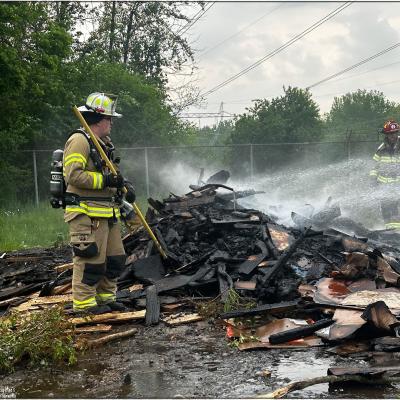Thirty-two years ago, Rick Nemier picked up his phone and called his local fire department. His six-month-old daughter was having a seizure and needed CPR. The firefighters were able to keep his daughter breathing. The support and care his family received was something Nemier couldn’t forget. As the son of a Syracuse firefighter, Nemier was always interested in the job. Watching the firefighters save his daughter inspired him to join a department the way most do: as a volunteer.
“I’m not a rich man; I don’t have a lot of money,” Nemier said. “But I said, maybe I can give some time. So I walked over to the firehouse, filled out an application. That was in 1990, and I never left.”
According to a recent report from the Firefighters Association of the State of New York, volunteer fire departments save New York State taxpayers $4.7 billion annually. But Nemier and others say it’s becoming harder to attract and keep volunteer firefighters. FASNY officials say the number of volunteer firefighters in New York has decreased from 120,000 to around 80,000 in the last 20 years.
When Nemier started at the all-volunteer Nedrow Fire Department in 1990, he said the station had 45 to 50 members. They were able to go on fire calls while keeping a few people at the station on standby. Now, as the Nedrow chief, he said the department has 16 active members, which makes the job more difficult.
“I appreciate all the help they give me,” Nemier said. “It’s not a one-person job. I always make sure I send kudos out to everybody because it’s a team effort. Without everybody working together, it’s tough.”
Career firefighters are paid and get benefits like dental, life insurance, paid vacation and more. They also tend to work in shifts, allowing them to take time off during the week. Volunteers work on call; they aren’t required to respond but are always alerted during an emergency. Whoever is available can assist.
John D’Alessandro, association secretary for FASNY, said because of the number of volunteer stations, those departments are taking on more calls, despite their small number of firefighters.
“You can see that just sheer numbers have dropped significantly,” he said. “At the same time, volunteer fire departments are going to far more calls, the complexity of those calls is increasing, and we’re often asked to go outside our own communities to provide assistance in other areas.”
Volunteers do not get paid but sometimes receive stipends, bonuses, tax exemptions or funding toward equipment in their station. Earlier this year, Gov. Kathy Hochul announced $10 million would be invested in volunteer firefighter training for recruiting and incentives.
D’Alessandro listed the governor’s funding efforts as a step toward increasing the number of volunteers. Still, he said his association has been working for years to get firefighters more health benefits.
“If I’m a factory worker and I fall off a ladder in the factory, I would qualify for a much larger payment than if I was a volunteer firefighter and I fell off the ladder,” D’Alessandro said.
In New York, if firefighters are hurt on the job, they are protected by a program similar to workers’ compensation called the volunteer firefighter benefit law. D’Alessandro said that while the volunteers get coverage, it’s at a low rate. The risk of being injured and possibly not having enough medical coverage adds to the worries volunteers may have about the job. But, in an Association-led focus group, D’Alessandro said they discovered three other reasons why numbers are decreasing: People don’t have the time, they don’t know where to start and they aren’t interested in emergency response.
Local departments are now letting their neighborhoods know fighting fires isn’t the only way they can help out their station. From bookkeeping to helping direct traffic at a scene, anyone can visit a department and ask how they can help.
“We’ve kind of created those opportunities, which is thinking outside the box, but it lets the residents in the community be part of the team and helps us out as being part of the team, which is great,” said Jon Barrett, second assistant chief in the Cicero Fire Department.
 Volunteer firefighters from the Cicero Fire Department respond to a fire in Oswego County.
Volunteer firefighters from the Cicero Fire Department respond to a fire in Oswego County.
In the past, it was required to be an interior firefighter to volunteer at a station. But Barrett said as more people are needed, interested community members are welcome, especially those with medical backgrounds.
At the Nedrow department, Nemier is happy to take in as many EMS volunteers as possible.
“Before it was, you had to be a firefighter first,” Nemier said. “But due to the fact that 75% of our calls are EMS related, I’m going for the EMS people if they want to come in and be EMS only, and if you want to take care of 75% of my calls, I’ll figure out what to do with the rest.”
Nemier, who is 65, said the department has members as young as 20 acting as EMS volunteers and assistant chiefs in their early 30s and late 40s. What they all have in common is their dedication to helping their neighborhood and a little extra time on their hands.
“If you sit down and figure it out and do a little time management, you can pretty much do the minimal amount of time here and still help us,” Nemier said. “And if everybody does that, we get another 20 people.”








